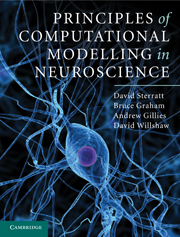Book contents
- Frontmatter
- Contents
- List of abbreviations
- Preface
- Acknowledgements
- Chapter 1 Introduction
- Chapter 2 The basis of electrical activity in the neuron
- Chapter 3 The Hodgkin–Huxley model of the action potential
- Chapter 4 Compartmental models
- Chapter 5 Models of active ion channels
- Chapter 6 Intracellular mechanisms
- Chapter 7 The synapse
- Chapter 8 Simplified models of neurons
- Chapter 9 Networks of neurons
- Chapter 10 The development of the nervous system
- Chapter 11 Farewell
- Appendix A Resources
- Appendix B Mathematical methods
- References
- Index
Preface
- Frontmatter
- Contents
- List of abbreviations
- Preface
- Acknowledgements
- Chapter 1 Introduction
- Chapter 2 The basis of electrical activity in the neuron
- Chapter 3 The Hodgkin–Huxley model of the action potential
- Chapter 4 Compartmental models
- Chapter 5 Models of active ion channels
- Chapter 6 Intracellular mechanisms
- Chapter 7 The synapse
- Chapter 8 Simplified models of neurons
- Chapter 9 Networks of neurons
- Chapter 10 The development of the nervous system
- Chapter 11 Farewell
- Appendix A Resources
- Appendix B Mathematical methods
- References
- Index
Summary
To understand the nervous system of even the simplest of animals requires an understanding of the nervous system at many different levels, over a wide range of both spatial and temporal scales. We need to know at least the properties of the nerve cell itself, of its specialist structures such as synapses, and how nerve cells become connected together and what the properties of networks of nerve cells are.
The complexity of nervous systems make it very difficult to theorise cogently about how such systems are put together and how they function. To aid our thought processes we can represent our theory as a computational model, in the form of a set of mathematical equations. The variables of the equations represent specific neurobiological quantities, such as the rate at which impulses are propagated along an axon or the frequency of opening of a specific type of ion channel. The equations themselves represent how these quantities interact according to the theory being expressed in the model. Solving these equations by analytical or simulation techniques enables us to show the behaviour of the model under the given circumstances and thus addresses the questions that the theory was designed to answer. Models of this type can be used as explanatory or predictive tools.
This field of research is known by a number of largely synonymous names, principally computational neuroscience, theoretical neuroscience or computational neurobiology.
Information
- Type
- Chapter
- Information
- Publisher: Cambridge University PressPrint publication year: 2011
